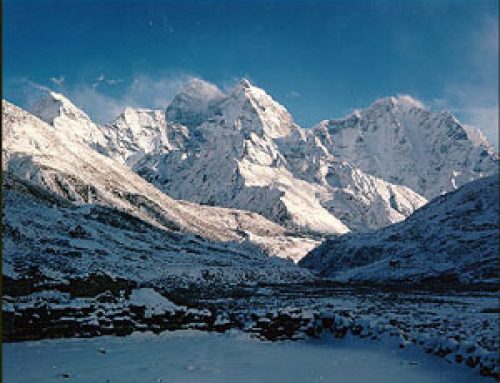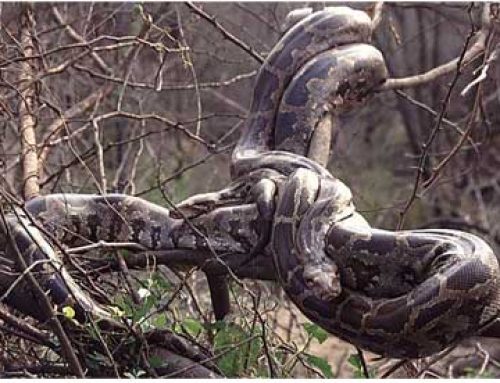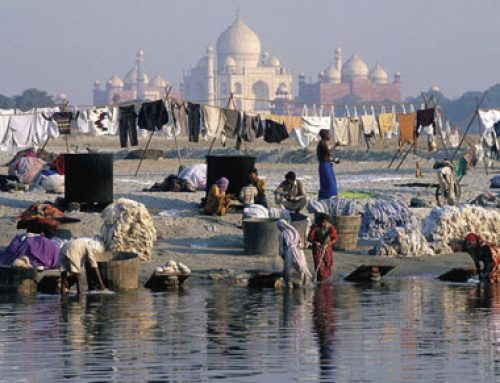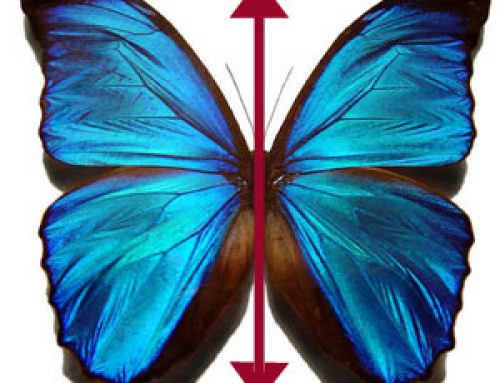
The Quaternary Period includes today – big cities and all
When was the Quaternary Period?
The Quaternary period began about 1.8 million years ago (1,800,000 years ago), coming after the Tertiary. The Quaternary is still going on today – we live in the Quaternary period. So far, it’s a much shorter period than the others.
Go back to the Tertiary
More geological periods
Stone tools and Ice Ages
At the beginning of the Quaternary period, early people in Africa were already using stone tools. The climate was mostly on the cooler side, with ice ages coming and going every forty thousand years or so. There were big ice caps at the North and South Poles, as there are today. Among the bigger mammals were saber-toothed tigers, mammoths and mastodons, small ancestors of horses, and wolves.
Early African history
All about flint tools
Where did horses come from?
People started to use fire
 A million years later, about 800,000 years ago, people began using fire to cook their food. These people gathered fruit and roots and grains, and scavenged meat left over by other animals. They caught a lot of fish, and gathered mussels on sandy beaches.
A million years later, about 800,000 years ago, people began using fire to cook their food. These people gathered fruit and roots and grains, and scavenged meat left over by other animals. They caught a lot of fish, and gathered mussels on sandy beaches.
Early history of food
History of fire
Neanderthals, Denisovans, and Homo Sapiens
By about 400,000 years ago, people had divided into three or more groups – one was the Neanderthals, and another was the Denisovans, and a third was our own ancestors, homo sapiens. By 350,000 years ago, some Neanderthals had left Africa and were living in West Asia and Europe. Some Denisovans were living in Central Asia. About 200,000 years ago, people in East Africa were trading obsidian as far as a hundred miles away.
Early primates
What is obsidian?
Homo Sapiens leaves Africa

Khoisan rock painting from South Africa showing someone hunting with a bow and arrow
By about 180,000 years ago, an Ice Age may have caused some people in Africa to begin to wear clothes. By 64,000 years ago, they had invented the bow and arrow.
History of clothing
Bows and arrows
About 60,000 years ago, probably drawn by changing climate at the end of another Ice Age, some modern people left Africa and traveled along the coast of South Asia into India and then over to Southeast Asia. There they met other people – the Denisovans – and mixed with them. Then the descendants of these people moved further east to Indonesia and Australia.
Stone Age China
Stone Age Japan
A little later, other people moved out of Africa north into West Asia and then into Europe, Central Asia and China. These people lived alongside the Neanderthals for a while, and mixed with them. By about 30,000 years ago all the pure Neanderthals had died out, perhaps killed off by our ancestors or by sicknesses and tapeworms carried by our ancestors, or possibly by cold weather. But most modern humans are also part Neanderthal.
What’s a tapeworm?
Crossing into the Americas

Mastodon
From 22,000 to about 16,000 years ago, there was another Ice Age, which caused more human migrations. In Europe, people moved south into Spain and Italy. From Central Asia, people moved south on to the Deccan Plateau in central India. Other Central Asian people may have used the land bridge that appeared at this time to cross over from East Asia into North America (or they may have traveled along the coast by boat).
The Bering Land Bridge
Paleo-Indians in the Americas
About 12,000 years ago, the end of this most recent Ice Age left Earth in a time when it was warmer than usual and wetter, and everything grew really well. Many large mammals that were adapted for the cold died out, maybe because of the climate; more likely because people hunted them to extinction. The animals that disappeared included saber-tooth tigers, mammoths, and mastodons. In North America, horses, camels, and cheetahs died out too, but horses lived on in Central Asia and camels survived in South America.
History of dogs
History of camels
The beginning of farming
Other animals like cattle, goats, wolves, and dogs did fine. Probably because of the warmer, wetter climate, there was enough food available in many places that some nomadic hunter-gatherers settled down in one place and just got their food there. Soon afterwards, these people began to grow their own food – that was the beginning of farming.
History of farming
Armies and cities
The first farmers may have been in West Asia, but people were soon farming in Africa, China, and South America too. Farmers could feed a lot more people, but they had to defend their land from other people. They began to have a lot of children, to use as soldiers, and by 6000 years ago people were beginning to live in cities in Asia, Africa, and South America. Since then, farming and cities have gradually spread around the world, to Europe, then to North America, and finally to Australia. Today more than half the people in the world live in cities, and more people leave the country and move to cities every day.
Learn by doing: building a fire
More about the geological eras
Bibliography and further reading about the Quaternary period and geology:





[…] the first people left Africa. At Blombos Cave in South Africa, people were fishing about 70,000 BC, and by the time people got to Southeast Asia about 40,000 BC they certainly had early boats. […]